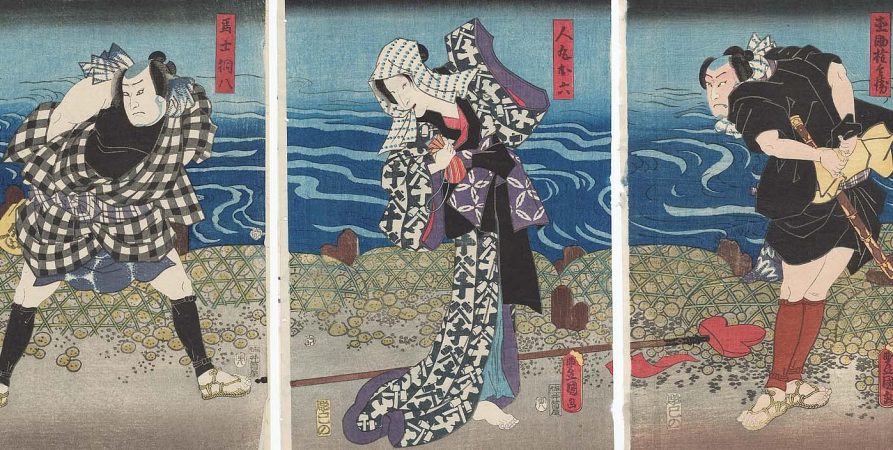Actors Sawamura Chōjūrō V as Tomoenojō and Iwai Kumesaburō III as Ōshū yūkon
Utagawa Kunisada (Utagawa Toyokuni III)
Life Story
Utagawa Kunisada (1786-1865) and publisher Ebisuya Shōshichi issued this actor-print diptych in connection with the kabuki play Sono omokage Asamagatake其俤浅間嶽 in 1849. Kunisada depicts the actor Sawamura Chōjūrō V as Tomoenojō, reading from a scroll, and actor Iwai Kumesaburō III as the Ghost of Ōshū (Ōshū yūkon) rising from the glowing ashes of a brazier. The loose folds of calligraphy paper between Tomoenojō’s fingers find a visual echo in Ōshū’ssupernatural cloud of incense, which snakes across the two sheets.
‘That Visage of Mount Asama’ is one way to translate Sono omokage Asamagatake. The production belongs to a group of dance dramas known as Asama mono that originated in Kyoto in 1698, in the same year that a Buddhist statue of Shinshū Asama Myōjin was unveiled. [1] In the drama, the ghost of Ōshū appears to admonish Tomoenojō for burning a mutual vow of love signed by the two of them. The dance conveys Ōshū’s resentment at her lover’s betrayal. [2]
Women were banned from performing on stage in 1622 on the grounds of public decency. This ban was reinforced with repeated prohibitions throughout the 17th century. [3] An all-male cast became a defining characteristic of kabuki drama, as it developed into a heavily stylized, non-realistic theatrical form. Within kabuki theatre, some actors specialized in performing female roles and were celebrated for their beauty, style and heightened femininity.
The Edo-born Iwai Kumesaburō III (Iwai HanshirōVIII, 1829-1882), depicted in the print, was an immensely popular leading female role specialist (J. tate onnagata). Kumesaburō III wears a wig stuffed with oversized hairpins that fan out around the actor’s face. Dressed as a high-status courtesan, with a loose front-tying sash holding together her many layers of clothing, Kumesaburō plays the spirit of a dead woman who has returned to visit her lover, Tomoenojō. The blue shade of the actor’s outer kimono, simply decorated with an iris flower, would have reminded the audience of the plain, colourless robes (J. kyōkatabira) of the deceased.
Iwai Kumesaburō III performs alongside Sawamura Chōjūrō V (Sawamura Sōjūrō V, 1802-1853), who was a handsome and talented actor and dancer. Also from Edo, Chōjūrō V performed both male (J. tachiyaku) and female onnagata roles. His casting in gentle, male roles was well received in the Osaka-Kyoto region that had developed a distinct style of Kamigata kabuki. [4] Sawamura Chōjūrō V, held the name Sawamura Tosshō I between 1831 and 1844, and is depicted in Utagawa Kuniyoshi’s design in the Sainsbury Centre Collection (object number: 41460).
Sono omokage Asamagatake opened at the Nakamura Theatre in Edo, in the 9th lunar month of the second year of Kaei (1849). [5] The government-appointed censor’s seals indicate that the print was issued between 1846 and 1852. [6] While the actors’ names do not appear on the print, their roles are given in the red coloured cartouches. This information, combined with the actor’s nigao or ‘likenesses’, has helped scholars of kabuki theatre to identify the one-scene dance drama (J. shosagoto) portrayed in the print. This was performed as the grand finale (J. ōgiri) of a mixed programme.
Vanessa Tothill, May 2020
[1] Samuel L. Leiter, New Kabuki Encyclopedia: A Revised Adaption of ‘Kabuki Jiten’ (Westport, Connecticut; London: Greenwood Press, 1997), p. 25.
[2] Satoko Shimazaki, Edo Kabuki In Transition: From the Worlds of the Samurai to the Vengeful Female Ghost (New York: Columbia University Press, 2016), pp. 185-86.
[3] Shimazaki, p. 86.
[4] Leiter, p. 559.
[5] Art Research Center Collection, Ritsumeikan University (object number: arcBK03-0094); Basil Stewart, A Guide to Japanese Prints and Their Subject Matter (New York: Dover Publications Inc., 1979), pp. 375-76.
[6] Andreas Marks, Publishers of Japanese Woodblock Prints: A Compendium (Leiden; Boston: Hotei Publishing, 2011), pp. 478-79.
Further Reading
Samuel L. Leiter, New Kabuki Encyclopedia: A Revised Adaption of ‘Kabuki Jiten’ (Westport, Connecticut; London: Greenwood Press, 1997)
Andreas Marks, Publishers of Japanese Woodblock Prints: A Compendium (Leiden; Boston: Hotei Publishing, 2011)
Satoko Shimazaki, Edo Kabuki In Transition: From the Worlds of the Samurai to the Vengeful Female Ghost (New York: Columbia University Press, 2016)
Basil Stewart, A Guide to Japanese Prints and Their Subject Matter (New York: Dover Publications Inc., 1979)
Not on display
Title/Description: Actors Sawamura Chōjūrō V as Tomoenojō and Iwai Kumesaburō III as Ōshū yūkon
Born: 1849 approx - 1849 approx
Object Type: Print
Technique: Woodcut
Measurements: Image/support h. 370 x w. 510 mm
Inscription: Censor's seals
Accession Number: 41453
Historic Period: Edo period (AD 1600-1868)
Production Place: Asia, East Asia, Japan
School/Style: Utagawa School
The drama of Kabuki
Two Kabuki idols in the Sainsbury collection once raised eyebrows on the streets of Japan
Continue reading








